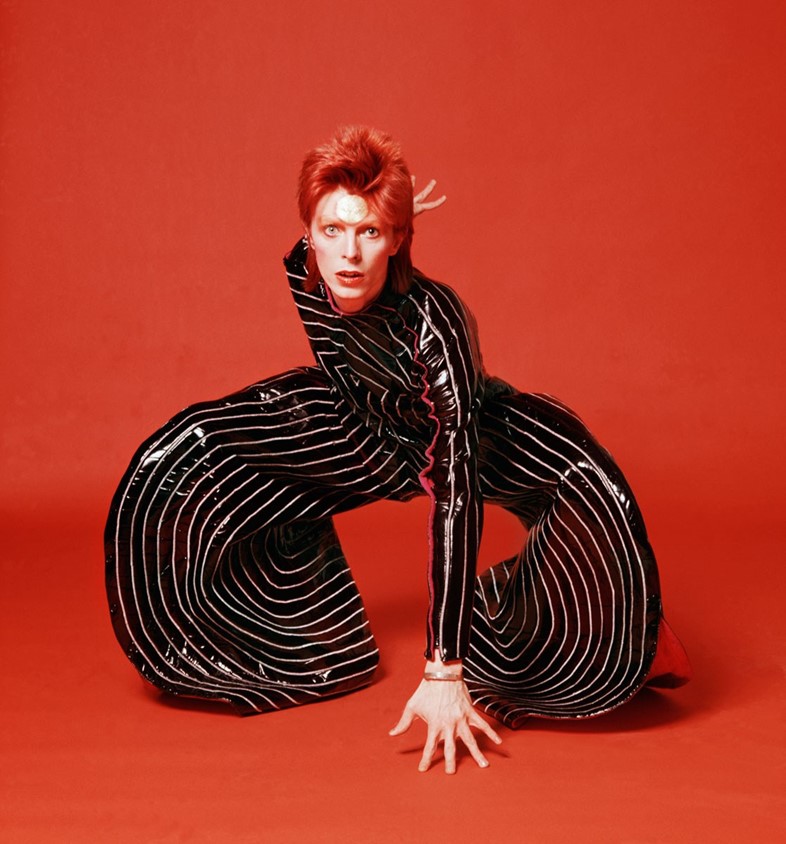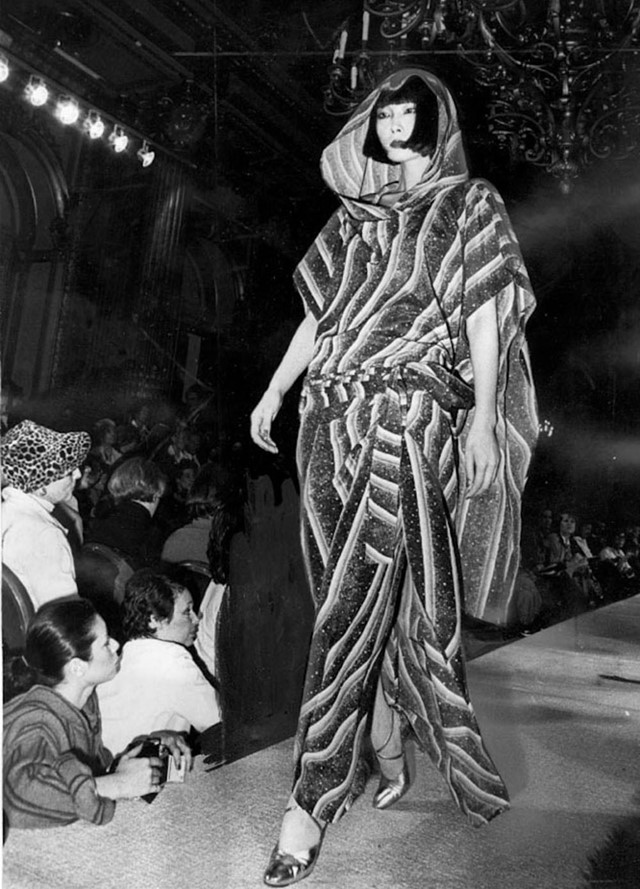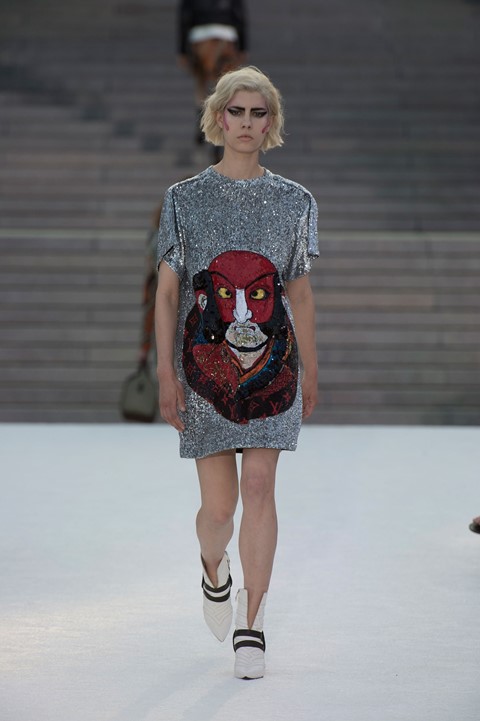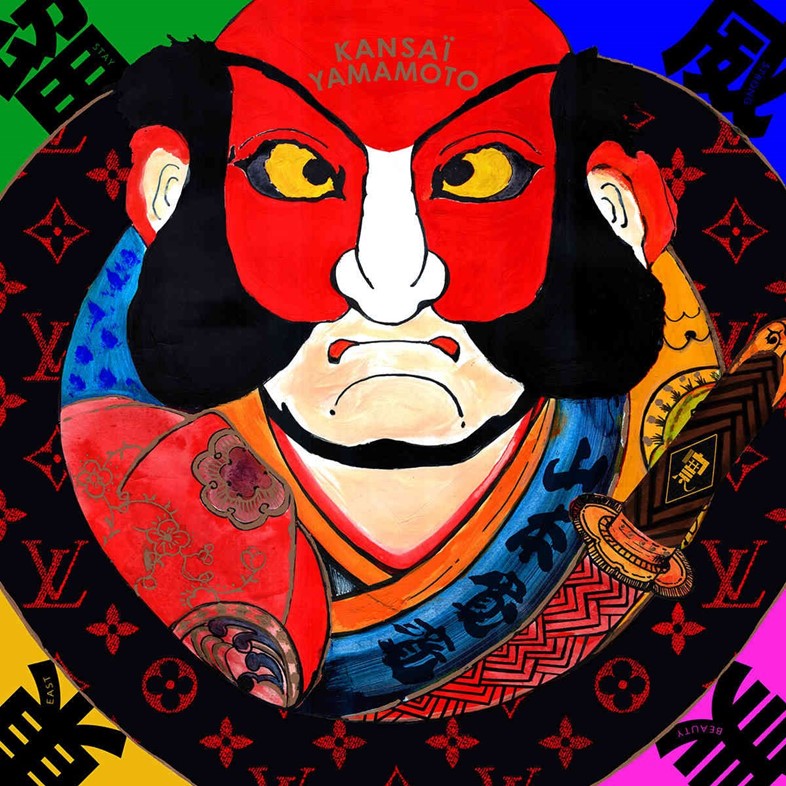Nicolas Ghesquière championed Kansai Yamamoto in the latest Cruise collection for Louis Vuitton; here, we take the opportunity to celebrate his outlandish legacy
Who? For the avid fashion fan, the most exciting attendee at Louis Vuitton’s Cruise 2018 spectacular – held at the Miho Museum an hour outside of Kyoto – wasn’t the usual gaggle of A-list starlets, it was the 73-year old Japanese guy in a natty red suit. That man is Kansai Yamamoto. We might be in the full throws of Comme des Garçons fever at the moment, but Yamamoto proves there’s another Japanese designer equally deserving of such attention. Born in 1944, today Yamamoto is a certified industry legend, but fashion nearly didn’t get him at all; he studied English and Civil Engineering at Nippon University prior to making the move into design. In 1971 Yamamoto debuted his collection in London; Paris followed five years later. Credited with being the first Japanese designer to show in Europe, he paved the way for his fellow countrymen and women who would follow suit years later.

What? Not one for the austere elegance of wabi-sabi favoured by many of his contemporaries, Yamamoto’s avant-garde aesthetic is bright, bold and big. Kaleidoscopic colours, outlandish proportions and theatrical layering define his work, and underpinning it all is a distinctly Japanese handwriting. From Hokusai-style wave prints and kimono silhouettes, to manga illustrations and patterns that riff on Yakuza tattoos, Yamamoto embraces the tropes of Japanese design and culture full throttle. Harujuku girls and Kabuki performers, geisha and Samurai warriors all have a home in Yamamoto’s universe.
It’s hardly surprising, then, that his work caught the eye of arch-Japanophile David Bowie. The two met when Yamamoto attended a Bowie gig at Radio City Music Hall in 1973, having been tipped off that the artist would be wearing some of his womenswear on stage. From there sprung not just a friendship but a creatively collaborative relationship in which the men – both visionaries in their own right – spurred one another on to the next level.

Today, Yamamoto’s legacy extends far beyond fashion, it’s engraved in pop culture; he’s perhaps best known as the mastermind behind some of the most spectacular looks from the Ziggy Stardust and Aladdin Sane eras. Legendary Yamamoto creations include a cartoonishly proportioned black and silver vinyl bodysuit, the Space Samurai – an outlandish version of the hakama loose trousers traditionally worn by samurais, and a kimono-inspired cape emblazoned with Japanese characters that spelled out Bowie’s name (but which also translate to “fiery vomiting and venting in a menacing manner”). He also introduced Bowie to the hayagawari technique favoured in traditional Kabuki theatre in which one layer is quickly ripped off to reveal another. The Bowie/Yamamoto connection is a perfect collision of two artistic minds, and showcases the powerful symbiosis that can exist between music and fashion. Would we have had Ziggy Stardust without Kansai Yamamoto? Not as we know him, that’s for sure.
Why? For houses of a certain mega-watt stature, the destination show is now de rigueur. Yet Yamamoto pre-empted all this global gallivanting with his ‘Super Shows’ of the 1990s, extravaganzas held in locations as far-flung as Moscow’s Red Square, India and Vietnam, their exuberance and showmanship matching that of the clothes. There was a neat homage to the designer, then, in Louis Vuitton’s Cruise 2018 collection which saw self-confessed Yamamoto fan-boy Nicolas Ghesquière bring the show on the road to Japan – a timely reminder that although he’s been somewhat off the fashion radar in the recent few years, Yamamoto’s influence still resonates.

For Ghesquière, Yamamoto’s role surpassed that of muse and shifted into collaborator territory. The collection’s razzle-dazzle dresses emblazoned with fierce samurai faces, and the Kabuki-eyed bags were among the (highly collectable) fruits of the partnership. However, Yamamoto’s influence can be seen throughout the Vuitton collection in more than just these motifs. The collection’s deliberate fusing of the east and west, technology and tradition, nods to a notion deeply entrenched in the designer’s work: the smashing of cultural boundaries and the celebration of difference. To see that most Parisian of houses salute him, we’d say it’s 1-0 to all the beautiful weirdos.
